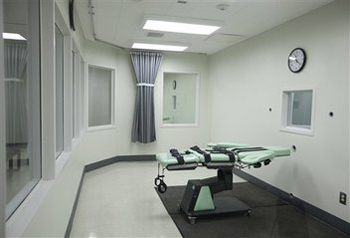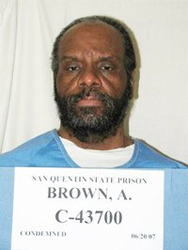
The death chamber of the new lethal injection facility at San Quentin. (Eric Risberg / Associated Press)
It has been 28 years since a Riverside County jury recommended the death penalty for Albert Greenwood Brown, a convicted rapist who attacked a teenage girl as she walked to school and strangled her in an orange grove.
Brown has sat on death row at San Quentin State Prison, awaiting the day when he would be put to death for his crimes. That day could arrive this week.
Brown, 56, is scheduled to be executed Wednesday at one minute after midnight. If that happens, he would become the first inmate to die by lethal injection in California since legal challenges halted the practice in 2006.
More than 75 people have been sent to death row, including three from San Diego County, since a federal judge ruled four years ago that there was a "disturbing" and "pervasive lack of professionalism" in the state's system for carrying out lethal injections.
As a result, the California Department of Corrections and Rehabilitation revamped its procedures for capital punishment and rebuilt San Quentin's death chamber.
Only a few factors remain that could stop Brown's execution. A lawyer for Brown has asked Gov. Arnold Schwarzenegger for clemency, a request the Riverside County District Attorney's Office and the victim's family vehemently oppose.

Albert Greenwood Brown, 56, is scheduled to be executed Sept. 29.
"It is unconscionable to put decent, law-abiding citizens through this prolonged nightmare," Angelina Jordan, 70, wrote in a letter to the governor. Three decades have passed since Oct. 28, 1980, the day her 15-year-old daughter, Susan Louise Jordan, was raped and murdered.
"This execution must take place. No more clemency. No more appeals. No more delays. No more stays due to technicalities and legal loopholes," the mother wrote. "Where is our clemency? How much longer must we endure this injustice?"
Last week, a San Francisco appeals court lifted a stay imposed in 2007 by a Marin County Superior Court judge who ruled that the revised lethal-injection procedures had not undergone a public review in compliance with state law.
California officials said the new procedures were publicly noticed this year and approved by state regulators in July. They went into effect Aug. 29.
"My guess is that it should go forward at this point," said Steven Semeraro, a professor at the Thomas Jefferson School of Law in San Diego.
The Marin County judge's stay, Semeraro said, was one of the last impediments keeping the execution from going forward.
But Brown's attorneys are expected to fight until the last minute to save his life. The lawyers plan to go back to court in Marin County on Monday.
U.S. District Judge Jeremy Fogel, who issued the temporary ban on lethal injections four years ago, has denied Brown's latest request for a stay of execution, allowing him the choice of whether to die by a three-drug cocktail, as the state protocol dictates, or by a single-drug dose, which some argue is less painful.
Brown's lawyers have argued that the execution could constitute "cruel and unusual punishment" because the state hasn't adopted sufficient safeguards to ensure that nothing will go wrong. They contend that the execution team assigned to Brown could not have been properly trained in the four weeks since the new procedures went into effect.
"Brown is scheduled to be executed pursuant to the same - or worse - Lethal Injection Protocol which already has not passed constitutional muster," they said in court documents.
But attorneys representing the state said much has changed since December 2006, including extensive training of the execution team and construction of an $853,000 death chamber at San Quentin, a project that began in 2007.
Brown had been on parole for a previous rape conviction when he attacked, raped and strangled Susan Jordan with one of her shoelaces. He took her schoolbooks and student identification card, left her body in the dirt and went to work cleaning cars.
That evening, as Susan's family searched for her, Brown called the family home several times, according to prosecutors. He asked the girl's mother, "Susie isn't home from school yet, is she?" and eventually told her where the body could be found.
"I have not forgotten that cruel, chilling phone call in which you so proudly made the statement, 'You will never see your daughter alive again,' " Angelina Jordan wrote in a letter addressed to Brown. The note was included with others from the family and attached to the Riverside district attorney's response to the clemency petition.
"Your day of accountability is now upon you," the letter continued. "The Jordan family will be watching."
The last death row inmate executed in California was Clarence Ray Allen in January 2006.











